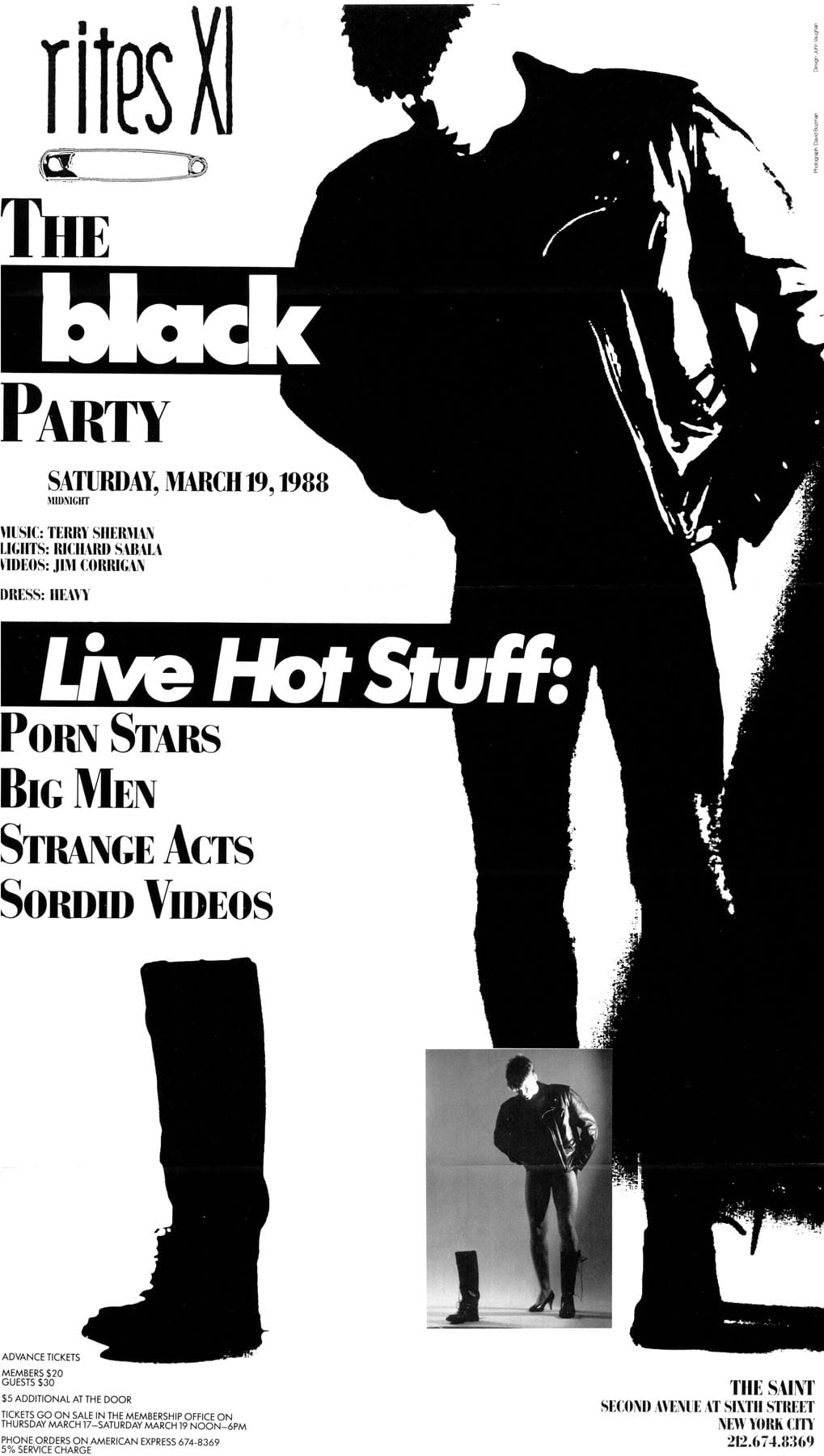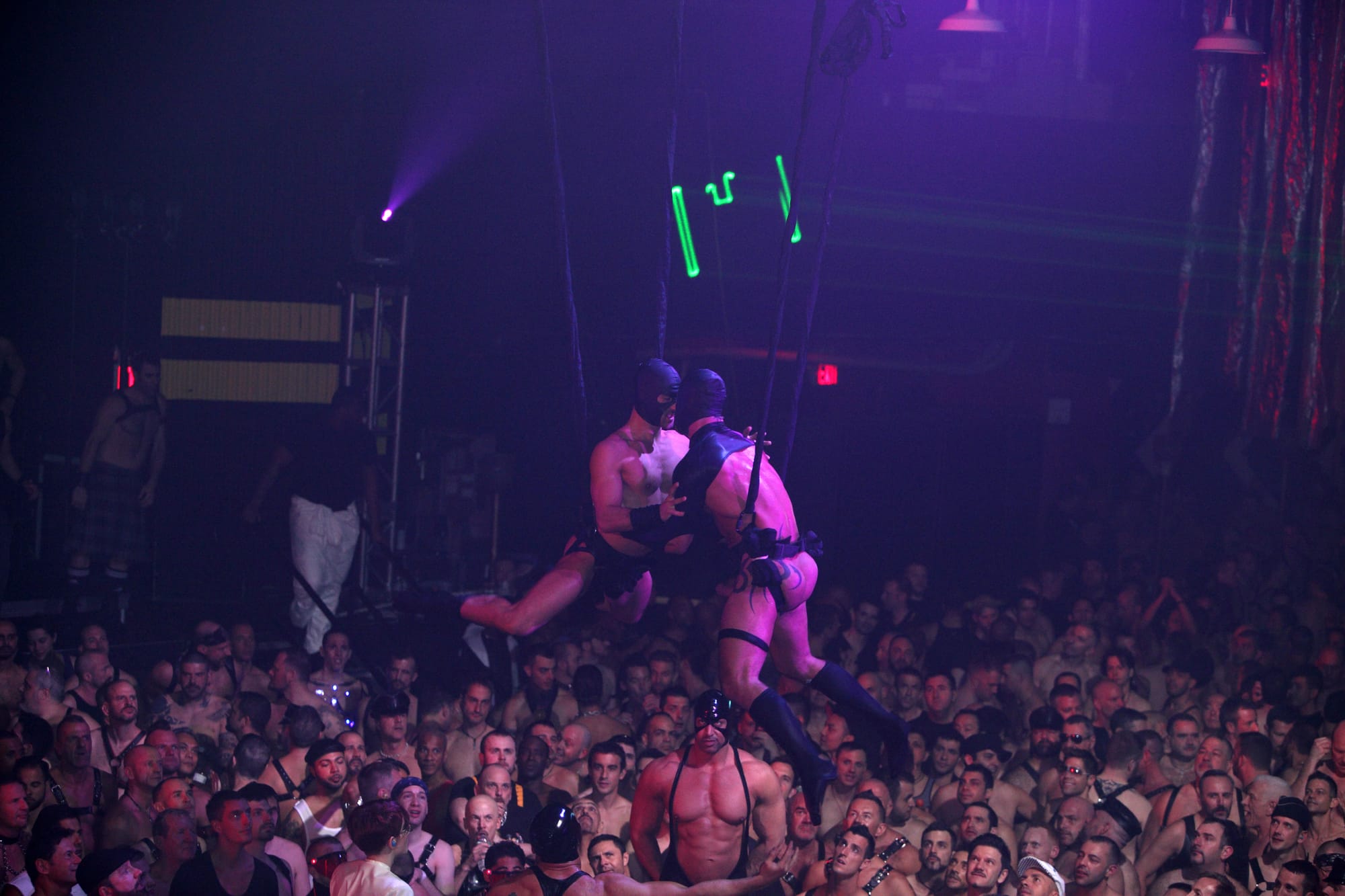In a world where hostility grows towards the LGBTQ+ community everyday with anti-queer legislation like “don’t say gay” and “anti-drag” bills, queer people need places to find queer joy and hope. Sometimes that hope and joy can be found in the most unlikely places — like through the Saint Foundation’s archives from the 1980s and ’90s that uncover how queer people celebrated their lives through wild nights of love, music, and theatrical gags even with all odds stacked against them during the AIDS Crisis.
Better yet, queer people can revisit queer history and experience the longest lasting circuit party that grew into a symbol of queer love and sexual liberation for over 40 years.

The notorious Black Party is back after a five-year hiatus and it’s paying homage to the queer community’s punk roots. The last time The Saint At Large party popped off was in 2019, ironically themed, “Caligula: The Last Party.”
The Saint At Large team has spent the last five years figuring out how to relaunch their signature “Rites of Spring” celebration in a post-COVID shutdown world while remaining true to the party’s 40 year freaky-fun traditions. Each year, the party invites attendees to shed their winter skins and immerse themselves fully in its intoxicating atmosphere.

Historic Roots
At midnight on September 20th 1980, The Saint nightclub opened in New York City’s East Village and queer nightlife in the city shifted forever. The iconic discotheque is described as a “cultural touchstone that shaped the very fabric of New York City’s nightlife and LGBTQ+ identity.”
Known for its theatrical performances involving a legendary soundsystem (for its time), lighting effects, and featuring some of the most celebrated queer artist of its era like Keith Haring, Andy Warhol, and Thierry Mugler, The Saint created a gallery of queer expression for its patrons to experience. Even in all of its official documents, The Saint was referred to more as a theater than a nightclub.
The Saint was a who’s who in the ‘80s and ’90s that donned performances from entertainers like Bonnie Tyler, Tina Turner, The Weather Girls, Grace Jones, Divine, Eartha Kitt, Natlie Cole and of course, the favorite drag queen of the ’90s, RuPaul.
According to an article from Them.us, on July 3, 1981 — ten months after The Saint opened — The New York Times reported the first-ever news story about a then-unknown disease: “RARE CANCER SEEN IN 41 HOMOSEXUALS.” At first, it was called GRID, or “gay-related immune deficiency.” Later, it was called AIDS. Among gay men in New York, it had another name: Saint’s Disease.
After its physical doors shuttered 1988 due to withering queer community due to AIDS and increasing cost of memberships, The Saint’s legacy continued through productions like The Black Party from The Saint At Large production company and with The Saint Foundation’s efforts to preserve queer culture for future generations.
The foundation’s mission is to acquire and preserve artifacts of New York City LGBTQ+ nightlife of the post-Stonewall era in order to create a chronicle of the socio-economic, political, and cultural history of the New York LGBTQ+ community.
Some items that the foundation has preserved include:
- Leather fetish gear, costumes and headpieces; (with original pieces by fashion designers including the Baroness, Miodrag Guberinic, Gerrold Vincent, Comely.
- The Saint branding, including envelopes, paper, and business cards bearing The Saint logo in its different styles as it has evolved.
- Periodical magazines, books, pamphlets, and zines from 50 years of gay life in New York.
- Rare matchbooks from establishments that were popular in the ‘80s and ‘90s.
- An audio archive, LIVE AT THE SAINT, culled from 40 years of recorded DJ sets on reel-to-reel tapes and digital files.

This year’s Black Party production sees Gio Black Peter as the evening’s creative director and he says The Black Party is an institution with a long history of bringing art, music, and culture to New York City nightlife. He adds that The Black Party is “our legacy as queers, to be passed down from one generation to the next and the experience and spiritual connections made at the party inform our queer family tree.”
“The Black Party is considered the father of all large circuit events and remains one of the most historic gay dance parties in the world, with thousands of attendees spanning four decades,” he said. “With a 44-year history in New York City, The Saint At Large has retained its reputation for cutting-edge event design and an unparalleled fusion of art, music, and sexual expression.”
Throwing large parties and preserving queer nightlife is key to The Saint At Large. The 2020 party was themed the punk party and was set for April 4, 2020, said Stephen Pevner, president, owner and executive producer of The Saint At Large. And then we all know what happened next: COVID-19 shutdowns.
COVID Complications
Leading up to the COVID-19 shutdowns in 2020, Pevner and his team were constantly talking with the New York City Health Department and monitoring the disease as it moved across the world, shuttering businesses and taking lives.
“We were all like, ‘What do we do because we’re spending a huge amount of money you know,” Pevner explained. “When you do productions, you have to put money down [to secure] the venue, you put money down for the DJs and lighting and sound — so we have spent a hefty amount of the budget already.”
Regardless of the money spent, the proverbial ax for the party dropped on March 14 when New York City began shutting everything down for the health and safety of its population.
On top of the event being canceled, The Saint At Large was denied any COVID relief funding because of the “sexual nature” of The Black Party, Pevner said. The organization lost around $300,000 because of the COVID-19 pandemic which included ticket refunds, lost deposits, and staff pay.
The Economics of the Black Party
The Black Party estimated 1800 guests (venue capacity) in 2020 at $189 ticket bringing them to a total of $340,000. However this year, half the guests are redeeming tickets purchased for the 2020 party at a considerably lower price, so they need to be comped, Pevner said.
Pevner explained that when securing a venue for marathon parties like The Black Party, warehouses are preferred and run a six-figure price tag. Warehouses are a blank canvas for event producers, but that also comes with extra costs. EVERYTHING must be purchased or rented including generators, porta potties, decor, staff of 200+ and the production team must leave the venue spotless after 18 hours of complete party chaos.
“It was a huge blow to our bottom-line and a big loss this year in order to revive the brand,” he said.
Despite the setbacks COVID shutdowns created for The Saint At Large team, Communications Director Josh Bondi says the team is in full production mode and ready to play.
Punk and Preserving Queer Culture
“This is an intergenerational team of creatives that put The Black Party on,” he said. “It’s a privilege to get to work with queer people older than you and younger than you on a fixture that spans generations.”
Bondi explains that The Black Party isn’t just a “typical circuit party,” but rather a five-act opera bound in punk themes and laced with leather, fetish, and kink.
“More often than not, queer people align with the punk attitude in the rejection of normativity,” Bondi continues. “Punk is also very community based. Queers and punks are underground communities.”
Because of the extreme sexual nature of the event and “enhancements”’ partygoers participate in, Pevner said that safety is incredibly important for the Black Party. Harm reduction supplies including fentanyl test strips, narcan, and condoms are readily available as well as the New York City Health Department and paramedics. Water, Gatorade and snacks (specifically cookies) are always on hand.

And of course, The Black Party isn’t complete without its music which will carry partygoers through the full 18-hour marathon event. The Saint At Large member Eric de la Cruz is in charge of the DJ booking and has curated an all-star lineup including Phillip Kimball, Sharon White, William Francis, Jason Kendig, Skin, Waly Verdun, Will Automagic, and Chris Cruise.
“The marathon parties are part of my DNA but they do not exist in New York City anymore” de la Cruz said.
But, if you’re a nostalgic gay looking to capture the night on your phone, you are sorely mistaken. The Saint At Large team said that no phones are allowed at the Black Party. Attendees are asked to respect each other’s privacy and freedom of expression and it is mandated that phones and cameras be checked at the door and if you’re caught with a phone or recording device, you will be kicked out and blacklisted.
For more information about The Black Party and The Saint At Large, visit their website.




